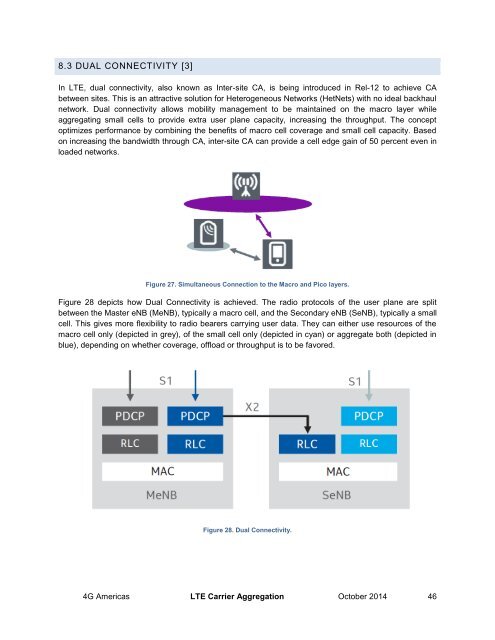8.3 DUAL CONNECTIVITY [3]In LTE, dual connectivity, also known as Inter-site CA, is being introduced in Rel-12 to achieve CAbetween sites. This is an attractive solution for Heterogeneous Networks (HetNets) with no ideal backhaulnetwork. Dual connectivity allows mobility management to be maintained on the macro layer whileaggregating small cells to provide extra user plane capacity, increasing the throughput. The conceptoptimizes performance by combining the benefits of macro cell coverage and small cell capacity. Basedon increasing the bandwidth through CA, inter-site CA can provide a cell edge gain of 50 percent even inloaded networks.Figure 27. Simultaneous Connection to the Macro and Pico layers.Figure 28 depicts how Dual Connectivity is achieved. The radio protocols of the user plane are splitbetween the Master eNB (MeNB), typically a macro cell, and the Secondary eNB (SeNB), typically a smallcell. This gives more flexibility to radio bearers carrying user data. They can either use resources of themacro cell only (depicted in grey), of the small cell only (depicted in cyan) or aggregate both (depicted inblue), depending on whether coverage, offload or throughput is to be favored.Figure 28. Dual Connectivity.<strong>4G</strong> <strong>Americas</strong> LTE <strong>Carrier</strong> <strong>Aggregation</strong> October 2014 46
8.4 CA FOR 5GThe 5 th generation cellular technologies (5G) have not yet been defined, but it is likely that CA will play animportant role in these technologies, too. Similar to CA in LTE-Advanced, 5G CA should also enableusing larger parts of the spectrum by a single device.Because the range of candidate frequencies for aggregation may become much wider in 5G, it is possiblethat the aggregated carriers would use different signal formats to better adapt to the operating frequencybands. When aggregating carriers with different signal formats, the CA framework may need to becomemore flexible compared to LTE-Advanced.As discussed in Section 8.3, in LTE, dual-connectivity is being introduced in Rel-12, which already allowsmore independent operation on different carriers. In dual-connectivity, unlike in CA, the physical layer andMAC layer signaling is not shared across certain groups of component carriers. For example, the channelstate information describing the DL channel within one carrier group has to be sent on a carrier within thesame carrier group. This way of operation reduces the need for tight, fast time scale coordinationbetween carrier groups. Note the dual-connectivity operation defined in Release 12 requires at least oneUL component carrier per carrier group, while in CA, a single UL among all component carriers issufficient. The same dual-connectivity framework might be evolved to allow aggregation of frequencieswith large separation.Similarly, future cellular technologies may provide more options to aggregate disparate air-interfaces. Inthese cases also, a more flexible framework is needed to enable simultaneous operation with differentsignal formats.Another future use case for CA is to overcome the unreliability of individual links. This might benecessitated by using frequencies with adverse propagation conditions or adverse interferenceconditions, the latter due to unlicensed use, for example. Even with reliable individual links, CA may beneeded to further improve radio channel availability and QoS for mission-critical applications.An important potential future enhancement for CA is to mitigate the negative impact of CA on devicepower consumption. This should include both advances in RF technology and improvements in thephysical layer/MAC procedures. The improved procedures should enable faster turning on/off of a givenCC. Further improvements may also allow the UE to determine the best CA operating configuration,especially in cases where there is only loose coordination between the aggregated eNBs. Therefore theeNBs may lack information about other links the UE is operating on.9. CONCLUSION AND RECOMMENDATIONSThe larger bandwidth provided by LTE-Advanced CA obviously results in improved user data rates. Butequally important, CA is a powerful feature that enables more flexible and optimal utilization of frequencyassets. Especially, non-contiguous CA offers new opportunities to use more and more frequencyresources for LTE in different bands.CA for LTE-Advanced is fully backward compatible, which essentially means that legacy Rel-8 terminalsand LTE-Advanced terminals can co-exist. The latter is achieved by relying on MAC level CA withindependent Release 8 compliant HARQ and link adaptation per CC. This also implies that CA istransparent from layer 3 and up for the user plane. A flexible layered approach for managing the CCs perLTE-Advanced user is defined, offering configuration of CCs per user via RRC signaling, followed byMAC signaling for activation/de-activation of CCs configured as SCells. The aforementioned control<strong>4G</strong> <strong>Americas</strong> LTE <strong>Carrier</strong> <strong>Aggregation</strong> October 2014 47


